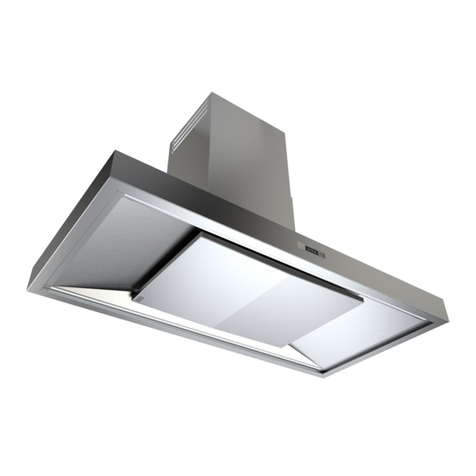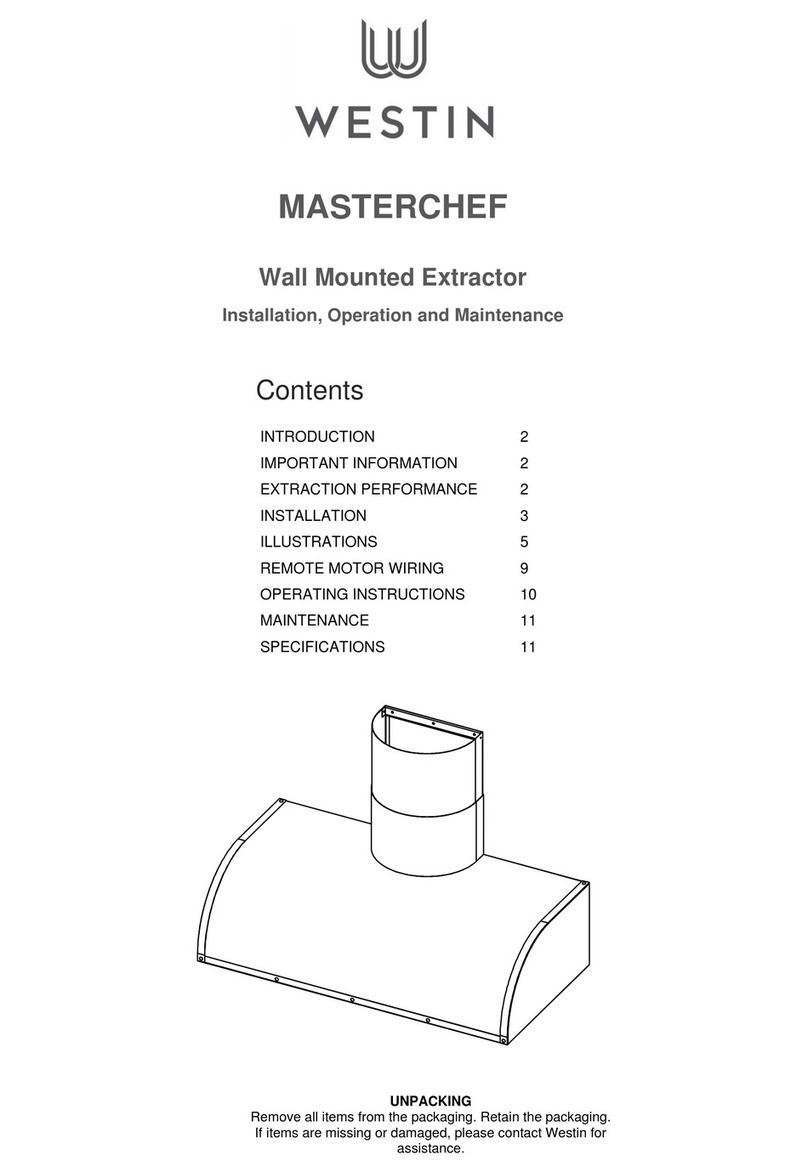W2074 WSW BLOQUE PRO Built-in Unit O&M 20220323.docx Page 1 Westin
1. INTRODUCTION
During the cooking process, there will be heat, vapours and
fumes produced. Your Westin Bloque Pro built-in extractor has
been designed to complement your kitchen both in looks and
performance in order to create a good environment for creative
cooking and is ideal for applications where a conventional
cooker hood is neither suitable nor desirable (in an inglenook
chimney or kitchen furniture above the hob for example).
2. IMPORTANT INFORMATION
The exhaust air must not be discharged into a flue which is used
for exhausting fumes from appliances supplied with energy
other than electricity e.g. oil or gas-fired central heating boilers,
gas-fired water heaters, etc.
Requirements of the relevant authorities concerning the
discharge of exhaust air must be complied with.
Pay particular attention to fire risk when frying. To minimise the
risk of fire, all instructions relating to cleaning the grease filters
and removing grease deposits must be adhered to.
Do not flambé under the extractor.
The clearance between the hob and the lowest part (base) of
the extractor should be within the following range, unless a
greater distance is specified by your cooking appliance or
furniture manufacturer:
•minimum clearance distances:
450mm above electric hobs and cookers
750mm above gas hobs and cookers, fryers
760mm above wok burners, griddles, barbeques.
•maximum recommended clearance: 850mm
The minimum distance between the hob and the bottom of the
extractor is essential for safety reasons and to prevent
overheating of the extractor and its components.
Please also note that a 90obend in flexible ducting will require
215mm minimum headroom to give a smooth radius with no
kinking.
You are advised to install measures designed to reduce the
incidence of cold draughts entering the property via ductwork.
•For extractors with internal or inline motors, an external
duct termination with integral non-return flaps (e.g. a
gravity shutter wall vent/louvre) is the minimum draught
prevention measure you should install.
•For wall-mounted motors an inline backdraught shutter is
recommended.
3. EXTRACTION PERFORMANCE
This type of extractor is designed to fit into a soffit, with only the
underside visible when installed.
Because fumes spread out as they rise, try to position the
extractor so it sits as far forward over the hob as is practicable
in order to minimise fume escape.
The primary influence on the overall performance of the
extractor is the design of the ducting which takes the exhaust
air from the extractor to the outside. The duct route should be a
prime consideration during the initial stages of the kitchen
design. Westin do not recommend recirculating air back into the
kitchen if it can be avoided.
Please note the following:
•The extractor is provided with a spigot(s) suitable for
connecting 150mm round ducting.
Note: the cross-sectional area of 150mm diameter duct is
the minimum area consistent with efficient extraction.
•The most efficient configuration is to duct straight through
an outside wall, so try to position the cooker close to an
outside wall when designing your kitchen.
•For maximum efficiency, ducting should be kept as short as
possible and as straight as possible with a constant cross-
sectional area being no less than that recommended by
Westin. Bends in the duct will also degrade performance so
the number of bends in a duct run should be kept to a
minimum and be gradual and smooth to prevent turbulence.
Avoid kinks in flexible ducting; pull flexible ducting taut over
straight runs to ensure that theinternal surface is as smooth
as possible.
•If your duct route is straight but exceeds 7m in length, or
exceeds 5m with three bends, then please consult with
Westin as to the suitability of this hood for your application.
•Rigid 150mm round ducting or 220 x 90 flat channel ducting
(available from Westin) will perform best. Semi-rigid round
duct (not flexible foil or PVC) is a reasonable alternativeand
can be formed into bends as necessary.
Flexible ducting is economical but its use should be
minimised because it gives the worst performance of all and
should only be used for the initial connection between the
hood and your fixed ductwork or for very short runs. Flexible
duct must be pulled taut over straight runs to prevent
significant losses in extraction efficiency.
•Try to maintain access to the duct route during installation.
Blind fitting of ducting parts can lead to problems, such as
unseen kinks or damage.
•If using rigid ducting, the initial duct connection to the
extractor spigot should be made using semi-rigid round
ducting. This will allow ducting to be connected to the
extractor before inserting it into furniture, allows for easy
removal and refit (if service is ever necessary) and gives
tolerance for positioning errors between the extractor and
any fixed ducting or holes.
•Ducting components and kits, are available from Westin.




































